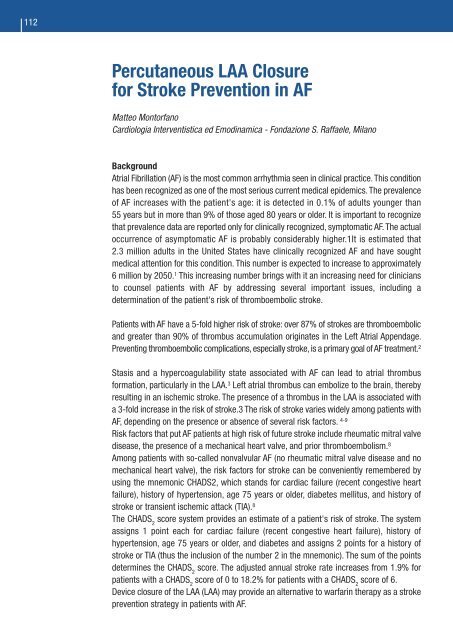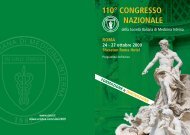HEARTLINE HSM Genoa Cardiology Meeting - Aristea
HEARTLINE HSM Genoa Cardiology Meeting - Aristea
HEARTLINE HSM Genoa Cardiology Meeting - Aristea
You also want an ePaper? Increase the reach of your titles
YUMPU automatically turns print PDFs into web optimized ePapers that Google loves.
112<br />
Percutaneous LAA Closure<br />
for Stroke Prevention in AF<br />
Matteo Montorfano<br />
Cardiologia Interventistica ed Emodinamica - Fondazione S. Raffaele, Milano<br />
Background<br />
Atrial Fibrillation (AF) is the most common arrhythmia seen in clinical practice.This condition<br />
has been recognized as one of the most serious current medical epidemics. The prevalence<br />
of AF increases with the patient's age: it is detected in 0.1% of adults younger than<br />
years but in more than 9% of those aged 80 years or older. It is important to recognize<br />
that prevalence data are reported only for clinically recognized, symptomatic AF. The actual<br />
occurrence of asymptomatic AF is probably considerably higher.1It is estimated that<br />
2. million adults in the United States have clinically recognized AF and have sought<br />
medical attention for this condition. This number is expected to increase to approximately<br />
6 million by 20 0. 1 This increasing number brings with it an increasing need for clinicians<br />
to counsel patients with AF by addressing several important issues, including a<br />
determination of the patient's risk of thromboembolic stroke.<br />
Patients with AF have a -fold higher risk of stroke: over 87% of strokes are thromboembolic<br />
and greater than 90% of thrombus accumulation originates in the Left Atrial Appendage.<br />
Preventing thromboembolic complications, especially stroke, is a primary goal of AF treatment. 2<br />
Stasis and a hypercoagulability state associated with AF can lead to atrial thrombus<br />
formation, particularly in the LAA. Left atrial thrombus can embolize to the brain, thereby<br />
resulting in an ischemic stroke. The presence of a thrombus in the LAA is associated with<br />
a -fold increase in the risk of stroke. The risk of stroke varies widely among patients with<br />
AF, depending on the presence or absence of several risk factors. -9<br />
Risk factors that put AF patients at high risk of future stroke include rheumatic mitral valve<br />
disease, the presence of a mechanical heart valve, and prior thromboembolism. 8<br />
Among patients with so-called nonvalvular AF (no rheumatic mitral valve disease and no<br />
mechanical heart valve), the risk factors for stroke can be conveniently remembered by<br />
using the mnemonic CHADS2, which stands for cardiac failure (recent congestive heart<br />
failure), history of hypertension, age 7 years or older, diabetes mellitus, and history of<br />
stroke or transient ischemic attack (TIA). 8<br />
The CHADS 2 score system provides an estimate of a patient's risk of stroke. The system<br />
assigns 1 point each for cardiac failure (recent congestive heart failure), history of<br />
hypertension, age 7 years or older, and diabetes and assigns 2 points for a history of<br />
stroke or TIA (thus the inclusion of the number 2 in the mnemonic). The sum of the points<br />
determines the CHADS 2 score. The adjusted annual stroke rate increases from 1.9% for<br />
patients with a CHADS 2 score of 0 to 18.2% for patients with a CHADS 2 score of 6.<br />
Device closure of the LAA (LAA) may provide an alternative to warfarin therapy as a stroke<br />
prevention strategy in patients with AF.





